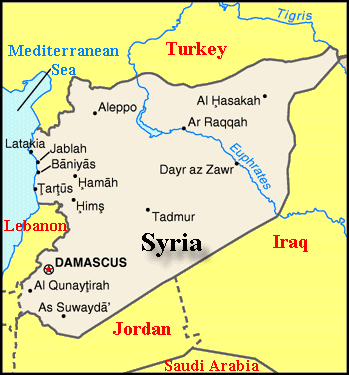Russia complicates Syrian situation

Map of Syria is shown in the photo
The Islamic State is not known for its prowess in the use of attack helicopters or supersonic fighters. Despite this fact, Russian and western officials have confirmed that Russia is sending several SA-22 “Greyhound” air defense systems to Syria as a part of its military aid to the Assad regime.
The presence of these systems, while presenting an eight-wheeled, boxy eyesore to the occupants of Latakia (where many SA-22s are being stationed), also presents a possible danger to Western militaries fighting against the Islamic State, as well as a larger geopolitical concern.
Though Western militaries headed by the United States have not committed their own soldiers in the region, they have carried out airstrikes against ISIS for around a year.
Many of these airstrikes take place in the sovereign airspace of Syria.
Though the Syrian military is overextended fighting Syrian rebels and the Islamic State, the presence of these air defense systems is still a cause for concern, and not because these systems pose an immediate threat to Western air forces.
The SA-22 is advertised as a “short range” air defense system (imagine the anti-aircraft guns of WWII, but add modern firing computers and make them fire several hundred times faster). Additionally, these systems have thus far only been deployed in Latakia, an Assad stronghold, so it is unlikely that Western air forces would be flying within range of these systems.
That said, the presence of these systems do not pose an immediate military threat. Instead, they represent a worrying long-term military threat.
At this point in time, it is clear that Russia has completed, or is very close to completing a base in Syria. Russian troops have been deployed into Syria in large numbers, and Russian fighter squadrons are being moved into the region.
The presence of troops, planes and armored vehicles can be excused by Russia’s commitment to protecting the Assad regime. However, the presence of air defense systems creates uncertainty of what Russia’s true intentions are.
As previously mentioned, the Islamic State does not have any air force to speak of. These weapon systems are essentially useless against the Islamic State, but are still being deployed in significant numbers by the Russian military, and are being operated by Russian crews.
These systems are being deployed to defend a Russian base located close to a warm water port, an economic asset that Russia holds in limited numbers.
It is evident that Russia is using the Syrian conflict to exert greater control over the Middle East. The creation of a base in the port city of Latakia, the deployment of air defense systems and the commitment to propping up the Assad regime all indicate that Russia is exploiting the current instability in Syria as a means to political and economic gain.
The aforementioned warm water port would be a massive asset to Russian shipping, and the increased military aid to Syria is no doubt helping Russia’s defense industry.
That being said, Russia’s presence in the region is a major long-term threat to peace within the Middle East.
Once Russia seizes a region, the nation is generally unwilling to give it up.
This has been a running theme in Russia’s recent history, including its unwillingness to grant autonomy to Warsaw Pact nations until the very end of the Cold War, and its recent annexation of the Ukrainian-owned Crimea.
Though the West has tolerated Russia’s annexation of Crimea, a military base right next to a warm water port held by different nations is another matter entirely.
There is no guarantee that the Assad regime will survive the Syrian conflict, and if a potential successor state wants the Russians to leave, there is a risk that the Russians will refuse. It is this possibility of refusal that makes the presence of Russian-crewed air defense systems in Syria such a cause for concern.
It is an act that indicates that the Russians are willing to defend their base against a force that actually has an air force.
Since the Assad regime is in no position to be bombing a base belonging to the country that is essentially arming the Syrian military, the only possible threat Russia could be anticipating is from Western militaries.
If the West wanted Russia to leave Syria and threatened military action, Russia would have the capability to fight against land or air forces. In a world where many Western nations and Russians are increasingly at odds, this is a very real possibility.

Nicholas Mortensen is a senior at Annandale High School and is a first-year staff writer at the A-Blast. Nicholas is an IB Diploma candidate, and is a...





